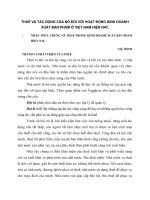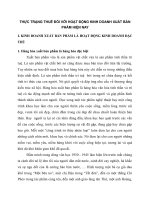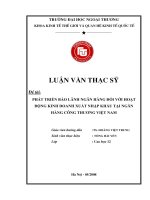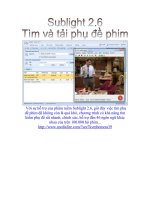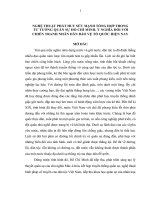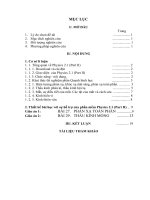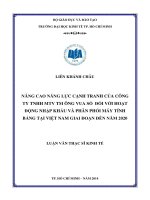SỰ hỗ TRỢ của GIÁO VIÊN đối với HOẠT ĐỘNG NHẬN xét CHO bạn học TRONG môn nói của SINH VIÊN năm 2 KHOA SPTA ĐHNN
Bạn đang xem bản rút gọn của tài liệu. Xem và tải ngay bản đầy đủ của tài liệu tại đây (674.77 KB, 71 trang )
ABSTRACT
Peer feedback activity has been appreciated by many researchers for its
various advantages towards students’ learning and development of soft skills.
However, this activity is not always successfully conducted in students’ English
speaking classes, due to the feedback’s limitations and students’ difficulties as
feedback givers and receivers. This study, therefore, looked into the ways teachers
facilitated that activity and the effects of such facilitation, specifically in the scope
of FELTE sophomores’ speaking classes. Participants of the study were 3 speaking
teachers of FELTE sophomores and their 79 students. The researcher employed
three data collection methods, which were questionnaire, teacher and student
interview, and observation. The results indicated many techniques that teachers
employed to facilitate peer feedback activity, together with the facilitation’s
positive effects on the students – as feedback givers and receivers – and on the
quality and quantity of feedback. The findings suggest the application of certain
facilitation techniques, as well as adjustments in the use of some others to enhance
their efficiency, thus better promote peer feedback activity in speaking class.
i
TABLE OF CONTENTS
ABSTRACT i
TABLE OF CONTENTS ii
LIST OF TABLES AND FIGURES vi
LIST OF ABBREVIATIONS vii
PART I: INTRODUCTION viii
1. Statement of research problem and rationale viii
2. Aims of the study and research questions viii
3. Significance of the research ix
4. Structure of the study ix
PART II: DEVELOPMENT xi
CHAPTER 1: LITERATURE REVIEW xi
1.1. Key concepts xi
1.1.1. Facilitation xi
1.1.2. Feedback xi
1.1.3. Peer feedback xii
1.1.4. Speaking xiii
1.2. An overview of peer feedback xiv
1.2.1. The roles of students’ peer feedback xiv
The role of students’ peer feedback in students’ learning xiv
The role of student peer feedback in students’ development of soft skills xv
The role of students’ peer feedback in the learning environment xv
1.2.2. Limitations of student peer feedback xvi
1.2.3. Students’ difficulties when conducting peer feedback activity xvii
ii
1.2.3.1.Difficulties from students’ attitudes xvii
1.2.3.2.Difficulties from students’ ability xviii
1.3. Teachers’ facilitation for peer feedback xviii
1.3.1. Building feedback partnership among students xix
1.3.2. Providing training on giving and receiving peer feedback xix
1.3.3. Providing encouraging feedback forms xx
1.3.4. Other strategies xxi
1.4. Conclusion xxi
Chapter summary: xxii
CHAPTER 2: METHODOLOGY xxiii
2.1. Scope of the study xxiii
2.2. Participants xxiii
2.2.1. Teachers xxiii
2.2.2. Students xxiv
2.3. Data collection instruments xxv
2.3.1. Questionnaire xxv
2.3.2. Interview xxvi
Interview for teachers xxvi
Interview for students xxvii
2.3.3. Observation xxviii
2.4. Data collection procedure xxix
2.5. Data analysis method and procedure xxxi
2.5.1. Data analysis method xxxi
2.5.2. Data analysis procedure xxxi
iii
CHAPTER 3: FINDINGS, DISCUSSION AND IMPLICATIONS xxxiii
3.1. An overview of peer feedback in FELTE sophomores’ speaking class xxxiii
3.1.1. Peer feedback occurrence xxxiii
3.1.2. Limitations of student peer feedback xxxiii
3.1.3. Students’ difficulties when conducting peer feedback activity xxxiv
3.2. Major findings, discussion and implications xxxvi
3.2.1. Major findings xxxvi
3.2.1.1.Research question 1 xxxvi
3.2.1.2.Research question 2 xlv
3.2.2. Discussion and implications xlix
PART III: CONCLUSION liii
1. Summary of the findings liii
2. Conclusion of the research liv
3. Limitations of the study and suggestion for further research liv
LIST OF REFERENCES lv
APPENDICES lx
APPENDIX 1: QUESTIONNAIRE FOR STUDENTS lx
APPENDIX 2: STANDARDIZED OPEN-ENDED INTERVIEW FOR
TEACHER PARTICIPANTS (translated by the researcher) lxiii
lxiv
1. APPENDIX 3: INTERVIEW GUIDE FOR STUDENT PARTICIPANTS
(translated by the researcher) lxv
APPENDIX 4: CLASS OBSERVATION SCHEME lxvi
APPENDIX 5: MARKING RUBRICS FOR GROUP PRESENTATIONS
(CLASS B) lxvii
iv
APPENDIX 6: SAMPLE TEACHER INTERVIEW EXTRACT lxviii
APPENDIX 7: SAMPLE CLASS OBSERVATION TRANSCRIPTION
EXTRACT lxx
v
LIST OF TABLES AND FIGURES
LIST OF TABLES
Table 1: Feedback types by Warner (2010, p.1) xii
Table 2: Groups of speaking teachers of FELTE sophomores xxiv
Table 3: Descriptions of student participants xxiv
LIST OF FIGURES
Figure 1: Feedback-focused observation tally scheme (Mackey & Gass, 2005,
p.199) xxix
Figure 2: Peer feedback occurrences noted in class A, B and C xxxiii
Figure 3 Students' opinion about limitations of student peer feedback xxxiv
Figure 4 Students reported difficulties when conducting PF activity xxxv
Figure 5: Techniques employed by teachers to facilitate peer feedback, as perceived
by students xxxvii
Figure 6: Teachers' ways to give immediate encouragement for student peer
feedback xlii
Figure 7: Teacher facilitation's effects on the feedback givers xlv
Figure 8: Teacher facilitation's effects on the feedback receivers xlvi
vi
LIST OF ABBREVIATIONS
ULIS University of Languages and International Studies
FELTE Faculty of English Language Teacher Education
PF Peer feedback
RQ Research question
vii
PART I: INTRODUCTION
1. Statement of research problem and rationale
The competitive labor market in Vietnam has been requiring undergraduates
to develop not only their knowledge and and soft skills, but also foreign languages,
among which is English. However, after four years studying English in university,
a lot of graduates are still described as being unable to use this language in real-life
contexts (Doan, 2008). Especially for the speaking skill, many graduates are
incapable of participating in discussions using English, being hesitate to speaking
English and afraid of others’ knowing their low proficiency (Le, 2011). This fact
raises considerations regarding English teaching and learning at university,
specifically about helping students overcome the hesitation to raise their voice so
that they can be more confident when using English in real-life situations.
A solution for this situation could be promoting student peer feedback (PF)
in speaking class, which is highly appreciated for helping learners familiarize
themselves with the real working world (Reynolds, 2009). In addition, peer
feedback activity can also help to enhance students’ critical thinking (Lam, 2010)
and collaborative skill (Nilson, 2003), which are among the essential soft skills.
However, due to the students’ personality, their level of English and level of critical
thinking, peer feedback might not successfully take place in an English class.
Teachers as facilitators, thus, have an important role in promoting peer feedback
among students. Nevertheless, this role of teachers in English speaking classes has
not received adequate attention from researchers.
These reasons urge the researcher to conduct a study on teachers’ techniques
for facilitating peer feedback and their effects on students’ peer feedback activity.
The study is entitled:
“TEACHERS’ FACILITATION FOR STUDENT PEER FEEDBACK IN
SPEAKING CLASS OF THE SOPHOMORES IN FELTE, ULIS”
2. Aims of the study and research questions
viii
The research was carried out to investigate the techniques used by the
speaking teachers to facilitate PF in a speaking class, as well as the effects of those
facilitation methods on the peer feedback activity. Thus, the study would answer
these two research questions (RQs):
RQ1: How do the teachers facilitate peer feedback in speaking class for second
year students in FELTE, ULIS?
RQ2: What are the effects of the teachers’ facilitation techniques on students’ peer
feedback activity?
3. Significance of the research
Once successfully conducted, the research could benefit both teachers and
second year students in FELTE, ULIS: As for the teachers, better understanding of
the issue will help them organize peer feedback more effectively in a speaking
class. They, consequently, will find it easier to conduct speaking lessons where
students receive more useful and more frequent feedback on their performances.
Thanks for that, the students will also benefit. The research findings can also be a
good reference for speaking teachers of other organizations, as well as teachers of
other subjects involving PF.
4. Structure of the study
There are three parts in this research:
Part I: Introduction
In this part, the rationale, aim of the study and the RQs are stated.
Part II: Development
Chapter 1 – Literature review – includes definitions of the key terms, an overview
of peer feedback activity and the teachers’ facilitation techniques for peer feedback.
Chapter 2 – Methodology – provides explanations for the study’s scope,
participants, data collection instruments and data analysis procedure.
Chapter 3 – Results, discussion and implications – is where data are analyzed to
answer the two RQs. Following the analysis are the discussions, including
implication and recommendation from the data.
ix
Part III: Conclusion
A summary of the findings, conclusion of the research, its limitation and suggestion
for further study are found in this part.
A List of references and Appendices are also included.
x
PART II: DEVELOPMENT
CHAPTER 1: LITERATURE REVIEW
1.1. Key concepts
1.1.1. Facilitation
Facilitation as the noun coming from the verb “facilitate” is the action of
making a process “possible or easier”, as stated in the Cambridge Dictionaries
Online. A facilitator is supposed to manage “the group process in order to help
groups achieve identified goals or purposes”, according to Thomas (2010, p.239).
As a person who facilitates, claims Schwarz (2005) cited in Thomas (2010), he or
she is to help enhance the effectiveness of the group. Facilitating is one of the
teachers’ roles and is considered to be very significant by Tylee (1999).
1.1.2. Feedback
Feedback, as educationally defined, is the information or comments that are
given after students perform a task, with an aim to improve their later performance
when conducting that same activity or a related one (Ende, 1983). Ende (1983) also
adds that it would be a mistake should “feedback” and “evaluation” be used
interchangeably since the former is formative while the latter is summative. In
contrast, Irons (2008) considers feedback as any piece of information based on
comments that could facilitate students’ learning; no matter the comments relate to
summative or formative assessment. Hattie & Timperley (2007), however, propose
a boarder concept, according to which feedback can sometimes be corrective,
clarifying or encouraging, depending on the agents that provide feedback. The most
well-known definition of feedback, however, is from Keh (1990):
[feedback] can be defined as input from a reader […] providing information to the
writer for revision […] comments, questions, and suggestions a reader gives a
writer to produce “reader-based prose” [ ] Through feedback, the writer learns
where he or she has misled or confused the reader by not supplying enough
information, illogical organization, lack of development of ideas, or something like
inappropriate word-choice or tense. (pp. 294-295)
Feedback has been classified differently by many scholars. Brookhart (1998)
as cited in Le (2010) labels four types of feedback: effective, descriptive, evaluative
xi
and motivational. Le (2010) also proposes another classification from Crane
(2006), by which there are five feedback types: confirmative, corrective,
explanatory, diagnostic and elaborative. Warner (2010), however, mentions only
two most familiar feedback types: formative and summative.
Table 1: Feedback types by Warner (2010, p.1)
Formative Feedback
This is feedback given during the
development of your work. You can use
formative feedback to improve the quality
of your work prior to final drafts or end of
course exams.
It includes:
• Comments on assignment drafts
• Discussions with lecturers and tutors
• Other communications from your
lecturers/tutors concerning your work
• Comments from others, including peers
and ALL staff.
Summative Feedback
This is feedback given after you have
finished and submitted your work and
cannot make any changes to it.
It includes:
• The grades or marks received for
written assignment tasks
• Exam grades or marks
• The grades or marks received for oral
assignment tasks
• Grades or marks given for assessed
group work tasks.
In this paper, the researcher follows Warner (2010)’s way of labeling
feedback for its clarity in comparison with other grouping methods. During a
speaking class of the sophomores in FELTE, ULIS, formative feedback could be
seen during their in-class practice and summative feedback often occurs after their
presentations.
1.1.3. Peer feedback
Literally, peer is defined as “a person who is the same age or has the same
social position or the same abilities as other people in a group” (Cambridge
Dictionaries Online). Therefore, in the context of a classroom, peer is understood as
the students themselves, among their classmates.
The term peer feedback has been used interchangeably with “peer review”,
“peer correction” and “peer critique” in many research papers. According to Lam
(2010), peer feedback as defined in pedagogy “assumes that students play the role
of the trained peer reviewers whose task is to give commentary on their partners’
initial drafts in either written or spoken mode” (p.114). In other words, peer review
or peer feedback takes place when there is an opinion from a student and the
xii
teacher will “ask a class Do you think that’s right?" or tell them to add a written
comment”, explains Harmer (2007) in Sultana (2009, p.12).
In the light of these definitions, the term “peer feedback” used in this
research is understood as the comments, opinions, contributions, corrections or
reviews that a sophomore in FELTE, ULIS can receive from their classmates, either
during or after their performance in speaking class.
1.1.4. Speaking
“Speaking is the productive aural/oral skill. It consists of producing systematic
verbal utterances to convey meaning” as defined by Bailey & Nunan (2004, p.48).
The aspects that underline one’s speaking ability, as stated by To, Nguyen, Nguyen,
Nguyen & Luong (2012) consist of “lexis and grammar”, “connected speech”,
“expressive devices”, “compensating language”, “language processing” and
“sociolinguistics knowledge” (pp.40-41).
Regarding the teaching of speaking, Bailey & Nunan (2004) discuss
audiolingual and communicative language teaching (CLT) method: While the
former is mostly based on behaviorism, stressing developing students’ good habits
by “a great deal of repetition” (p.49), the latter (which is recently more popular)
emphasizes “how students communicate when they speak the target language”
(p.50). The CLT lesson, therefore, offers many opportunities for the students to
practice the language they are learning.
Concerning the objectives of speaking practice activities, To et al. (2012)
pointed out precision (or accuracy) and automatization (or fluency). Accuracy
during one’s speaking, according to To et al. (2012), means that he or she “speak[s]
English without or with few errors in grammar, vocabulary and pronunciation.”
(p.42). On the other hand, fluency during one’s speech, meaning their ability to
communicate without too many pauses for thinking, is also crucial.
Taking principles of teaching speaking into consideration, Bailey & Nunan
(2004, pp.54-56) insist that teachers should:
xiii
(1) “Be aware of the differences between second language and foreign language
learning contexts.”
(2) “Give students practice with both fluency and accuracy.”
(3) “Provide opportunities for students to talk by using group work or pair work,
and limiting teacher talk.”
(4) “Plan speaking tasks that involve negotiation of meaning.”
(5) “Designing [design] classroom activities that involve guidance and practice in
both transactional and interactional speaking.”
From what has been discussed about “speaking”, the researcher would like
to note that peer feedback, as an activity in speaking class, can also serve to
develop students’ English speaking. In the particular case of FELTE sophomores,
as peer feedback is often required to be expressed in English, it can help students
enhance their fluency through expressing and discussing the comments, as well as
accuracy through recognizing others’ mistakes relating to various aspects of
speaking. By letting students conduct PF activity, teachers are following the
aforementioned principles of teaching language speaking skill, namely principle
(2), (3) and (4).
1.2. An overview of peer feedback
1.2.1. The roles of students’ peer feedback
• The role of students’ peer feedback in students’ learning
PF helps raise students’ awareness of their performance (or products). Lam
(2010), while particularly discussing peer feedback in writing class, insists on its
positive influence on improving the quality of students’ revision work. Explaining
for this, Reynolds (2009) argues that some students can actually ignore their
teachers’ remark but will pay attention to the problem once it is also noticed by a
peer. This is because PF has “greater volume, frequency and immediacy” compared
with teachers’ feedback, according to Topping (1998) cited in Nilson (2003, p.35).
Maarof, Yamat & Li Li (2011) also stress the awareness that PF raises in the
receivers by making them see “egocentrism” (p.30) in their own work. In addition,
through giving comments on others’ work, students will understand qualities of a
good work better, thus can complete their own work (Maarof et al., 2011).
xiv
Generally speaking, students will gradually be more in charge of their own
studying thanks to peer feedback (Sultana, 2009). PF as a teamwork activity can
“enhance students’ sense of autonomy and responsibility in the learning process”
agrees Jacobs (1989, as cited in Sadeghi & Baneh, 2012, p.910). With the support
from their friends, emphasizes Maarof et al. (2011), the activity also improves
students’ attitude towards the subject they are learning. In a writing class, for
example, students through giving-receiving peer feedback will be directly involved
in the process of writing and “become more critical readers and writers” (Sadeghi
& Baneh, 2012, p.910). In speaking class, using PF form during students’
presentation prevents inactive listening from the audience. (Nilson, 2003)
• The role of student peer feedback in students’ development of soft skills
This advantage is noted by Reynolds (2009), emphasizing the authenticity of
peer feedback activity. She compares the experience of asking for and receiving
peer comments to the real situation when ones “need to consult with colleagues and
supervisors to get an honest evaluation of their efforts” (p.54). Carrying out this
activity, says Reynolds, students are preparing “one another for life” (p.54). In
agreement with her, Nilson (2003) when referring to many other studies states that
peer learning can help boosting communication and collaborative skills, which are
among essential life skills. Mendonca & Johnson (1994) in (Sadeghi & Baneh,
2012) share this idea, saying PF can develop students’ communication ability by
encouraging them to “convey and negotiate their opinions” (p.909).
• The role of students’ peer feedback in the learning environment
Requiring students’ more attentive and proactive participation, PF helps
promote an engaged class where not only do the listeners have to “attend” but also
have to “offer concrete suggestions” (Reynolds, 2009, p.55) for their friends’
presentations. Gower, Phillips & Walters (1995) cited in Sultana (2009) also share
that “involvement indeed increases” (p.12) as students give PF to their peers on
their performance.
xv
Moreover, feedback offered by students among themselves is considered
less threatening than that from teachers, says Rollinson (2005, as cited in Sultana,
2009). Students are supposed to be more relaxed with their classmates, thus less
anxious when getting correction from them. The participation of peers in this case
makes the class “more supportive and friendlier” (Rollinson, 2005 as cited in Sultana,
2009, p.12).
Explaining for a more leaner-autonomous leaning environment, says
Rollinson (2005) in Sultana (2009), since comments and correction are no longer
given only by the teacher, the class are less teacher-dominated. When correction is
given by the teacher, Rollinson (2005, as cited in Sultana, 2009) goes on
explaining, it strengthens the teacher’s authority because he or she acts as the only
source for knowledge in traditional classrooms. Therefore, once the right for giving
feedback is distributed, it will indeed reduce the teacher’s dominance and enhance the
autonomy of students in the lesson.
1.2.2. Limitations of student peer feedback
Feedback from students is often questioned about its reliability. Novice as
they are, students might not able to help their friends with the revision work
(Maarof et al., 2011). Some researches mentioned in Lam (2010) reveal that
students’ feedback can be “neither reliable nor professional enough to use” (p.114).
Following are justifications for such unreliability:
• Bias: As cited in Nilson (2003), some researchers insist that assessment from
peers can be unfair, depending on race and friendship. Another factor contributing
to the bias in students’ peer feedback, adds Nilson (2003), is that when commenting
on others’ arguments, they often “focused on their agreement or disagreement”
(p.35), not on the arguments’ logic and evidence. Similarly, they are affected by
their “likes or dislikes of the work rather than its quality” (Nilson, 2003, p.35). The
bias does not necessarily come from students only, Nilson (2003) explains, since
they are simply answering questions on the feedback forms developed by their
teachers and many of those forms “indeed likely to evoke emotions in students” (p.35).
xvi
• Superficiality: The second problem in the quality of feedback is that
students have the tendency to focus on “surface errors instead of semantics or
textual one” as argued by Maarof et al. (2011, p.31). Nilson (2003) also affirms that
some students are “uncritical in general” (p.35). On the contrary, they are rather
shallow and tend to pay much attention on trivial problems like spelling.
• Inaccuracy: Compared to teachers, students as reviewers obviously
promise less accuracy. Whereas teacher feedback is regarded as a source of
“correctness, accuracy or appropriateness” (Maarof et al., 2011, p.30), student
comments receive doubts on their accuracy. Nilson (2003) has the same remark that
peer feedback can be neither accurate nor consistent.
• Vagueness: Being unengaged, lazy or simply unable to express their
ideas, some students provide rather vague comments which refer to almost no exact
point of the peer’s work (Nilson, 2003). The reason for this, claims Nilson (2003),
is that many students are not aware of the standards of a good work.
1.2.3. Students’ difficulties when conducting peer feedback activity
1.2.3.1. Difficulties from students’ attitudes
• Feedback givers’ attitudes
When giving peer feedback, even if it is invited, some students “feel very
awkward” (Withers, 2009, p.79). Since the student and his or her peer are in the
same position, becoming feedback giver and receiver can make them “fall
automatically into hierarchical roles”, says Withers (2009, p.79). This consequently
creates, continues Withers (2009), “discomfort or resentment” (p.79): The giver in
this case might be afraid to be dictatorial to his friend, thus finds it difficult to
provide him or her with comments. Similarly, Nilson (2003) also shares that
obviously most students “loath to find fault with one another products” (p.35) and
Sultana (2009) again states that perhaps students feel hesitant to correct their
friends for fear that it hurts the friendship. Carlson & Nelson (1996, as cited in
Sultana, 2009) even describe a case of Chinese students who had to repress their
critical feedback to preserve “group harmony” (p.13).
xvii
Hesitation also happens when students believe if they prove their ability to
identify mistakes, they would have “no excuse for their handing their own work
with weaknesses” (Nilson, 2003, p.35). In other words, students while giving peer
feedback might be very hesitant to express their critical minds, worrying that their
“insightful critiques may raise the instructor’s grading standard”, explains Nilson
(2003, p.35).
• Feedback receivers’ attitudes
Apparently, it is not at all easy to receive and accept criticism, especially
from “peers”. Sultana (2009) further demonstrates this idea by telling the feeling of
embarrassment in the receivers. The problem becomes serious as such criticism
occurs right where and when the whole class can witness, leaving the receivers feel
offended. Even when they are not offered feedback so publicly, students might be
very reluctant to give the peer their work for correction, simply not to let their
classmates know their mistakes (Sultana, 2009, p.13).
1.2.3.2. Difficulties from students’ ability
Another problem is believed to be the students’ inability to give effective
peer feedback. This may result from students’ low English level, which prevents
them from expressing their ideas using this language. Lam (2010, p.116) describes
a case of six students “whose English proficiency ranged from slightly above
average to slightly below average” claiming giving specific feedback was difficult
although they had already received training. Nilson (2003) also adds that sometimes
the problems come from students’ unawareness of the products’ standards.
From the discussion of students’ peer feedback’s limitations and their
difficulties, Nilson (2003) then comes to a straightforward conclusion:
[…] the problems with student peer feedback seem to boil down to three: the
intrusion of students’ emotions into the evaluative process, their ignorance of
professional expectations and standards for various types of work, and their
laziness in studying the work and/or writing up the feedback. (p.35)
Either from students’ attitude or ability, those problems in student PF
activity require teachers and researchers to come up with solutions.
1.3. Teachers’ facilitation for peer feedback
xviii
Many strategies to enhance the effectiveness of peer feedback activity have
been applied by teachers. Following is the discussion of such strategies and their
effects on students’ PF activity:
1.3.1. Building feedback partnership among students
As a means to eliminate awkwardness, “an environment of trust and caring”
needs to be built to encourage students, says Noddings (2009) cited in Reynolds
(2009, p.57). Also according to Reynolds (2009), teachers need to make all
students “feel like valued members of the learning community in large and small
ways” (p.57) through teachers’ informal conversations with students (e.g. about
their hairstyle or the coming tests). Another way to create a caring atmosphere can
be the teachers’ noting students’ birthdays, or students’ questions that they were
unable to answer. In such ways, claims Reynolds (2009), a trusting community is
built, helping students “go from fear to eagerness” (p.57).
Withers (2009) specifically stresses the importance of creating a strong
feedback partnership as to gradually eliminate awkwardness. The point is, argues
Withers (2009), “rather than ambushing someone immediately after some event”
(p.79), a contract needs to be created in advance. The PF givers should be informed
about the comments in need while the receivers should also be prepared for taking
feedback, instead of coming “out of the blue with ‘So, how did I do?’” (Withers,
2009, p.79). The feedback session, continues Withers (2009), should be planned by
the givers and receivers’ asking themselves set of questions, such as “How will I
prepare myself to listen well and to not react defensively?” (p.79). Serious preparation
for PF session eventually will enforce the feedback giving-receiving partnership.
1.3.2. Providing training on giving and receiving peer feedback
An exemplar for this technique is the experiment conducted in Hong Kong
University, reports Lam (2010). Lam implanted a workshop which provided
training on effective giving and responding to peer feedback in the writing skill.
The 2-week training covered three stages: Modeling, exploring and consciousness-
raising. The result was optimistic: students reported that they were positive “not
only about how to give effective peer feedback to their partners, but also how to
xix
evaluate how successfully peer feedback was incorporated into their own
subsequent revisions” (Lam, 2010, p.120). Some students were then reported to be
aware of PF’s importance and critical on their friends’ products, thus to “become
even more critical of their own writing” (Lam, 2010, p.120). A similar experiment
was also conducted in ULIS, VNU by Luu (2011) regarding peer feedback training
in writing class. Luu (2011) reports that the training brought about an increase in
both the quantity and quality of students’ peer comments. In addition, most
feedback givers showed their optimistic reaction to the development of skill as well
as the acquisition of knowledge and language.
Reynolds (2009) also suggests certain strategies for enhancing peer
feedback, emphasizing training students to take the leading role in the feedback
session. The teachers, in this case should only act as a discussion member, leaving the
monitoring work for the feedback receiver. At the beginning, Reynolds (2009) reports:
[…] students try to address their comments to me and look at me for confirmation.
But when the shift [of ownership] finally occurs, and the presenter smiles, ignores
my raised hand, and calls first on a peer. (p.57).
1.3.3. Providing encouraging feedback forms
Instead of using feedback forms that “evoke emotions in students”, Nilson
(2003, p.35) proposes a new feedback list, in which questions are worded in a
neutral way: This question list does not “ask for a judgment or opinion and so
evokes no emotion” (p.36). These questions are designed as students, familiar or
not with feedback rules, are still able to answer, and require students’ serious
attention to the work. Some sample questions are: “Outline this
paper/speech/project on the back of this sheet” or “Underline all the logical
transitions you come across in the paper” (for written products); “What do you
think is the weakest evidence for the writer’s/speaker’s position? Why?” or “List
the types of supporting evidence and/or experiences given in the paper/speech?”
(for oral presentations) (Nilson, 2003, p.36). This new feedback form, according to
Nilson (2003), serves as a direct answer for the previously mentioned problems with
students’ feedback because of its three advantages:
(1) The neutrality of “identification and personal reactions” (p.36)
xx
(2) Students’ capability of answering once they have read or listened to the work
(3) Students’ inability to ignore the work asked by the questions (i.e. “the keen
focus and attention to detail that these items require prevent once-over
skimming or lazy listening” (p.36))
From the researcher’s viewpoint, this way of wording feedback items can
solve most of the limitations and difficulties resulting from the students’ attitude.
Additionally, while training students and building students’ partnership require a
long-term plan from the teachers, Nilson’s solution can obviously bring about a
more immediate effect on students’ feedback.
1.3.4. Other strategies
Teachers’ grading the feedback can be an extrinsic motivation for the
students to give more responsible comments. Nevertheless, this would mean a
“formidable” task for the teachers, especially for large class size (Nilson, 2003, p.37).
Giving immediate encouragement for peer feedback, although not explicitly
discussed, is mentioned in many examples. A conversation cited in Sultana (2009)
as an example of in-class peer correction shows that the teacher, rather briefly, says
“Good” or “Thank you” as an encouragement for the feedback givers.
At this point, the researcher wants to highlight that many of the
aforementioned strategies are also proposed by Do (2009). It is noteworthy that
besides studying a much related topic with this research’s, Do (2009) also takes
second year students in FELTE as her subjects. The results of her research once
again suggest “teacher’s involvement” during students’ feedback session in the
following ways:
(1) Clearly assigning students specific aspects to comment on
(2) Setting up the feedback criteria with students’ opinions
(3) Marking students’ participation during the feedback session
(4) Providing an instructing course on giving and receiving peer feedback
1.4. Conclusion
Although peer feedback is said to be beneficial for teaching and learning,
there remains many disadvantages of this activity, as well as various difficulties
xxi
when conducting it. However, most measures to facilitate peer feedback discussed
in previous papers are either too general (applicable for all feedback sessions) or
only on English writing skill. In addition, as concluded by the researcher with her
limited access to previous literature, it is extremely difficult to find research
spotting on teachers’ facilitation for peer feedback in speaking class in the context
of Vietnam, not to mention at ULIS, VNU. The researcher thus decided that
teacher’s ways of facilitating peer feedback in speaking class, as well as the
facilitation’s effects should be the gap to study.
Chapter summary:
In this chapter, some key concepts are elaborated, together with an
overview of student PF that covers its roles, limitations and a list of students’
difficulties when conducting it. Significantly, the researcher has provided a review
of earlier research that discusses teachers’ facilitation techniques for student PF,
and the effects of those strategies. Besides, she has also indicated the gap to be
covered in this paper.
xxii
CHAPTER 2: METHODOLOGY
In this chapter, the researcher would provide justification for the study’s
scope, participants, data collection instruments and data analysis procedure.
2.1. Scope of the study
In this study, the researcher will only investigate into teachers’ facilitation
for students’ peer feedback in the context of English speaking classes for second
year students in FELTE, ULIS. The reasons to focus on only speaking classes (not
other English language skills) lied in the gap indicated in the literature review. As
for the choice for sophomores (not the freshmen, junior or senior students) the
explanation first could be found in their learning programs. Temporarily, the
freshmen in FELTE were using the new course outline, in which there were no
specific “speaking classes”. The FELTE junior and senior students, despite using
the familiar course outline including “speaking classes”, were not chosen either.
This was because they were assumed to be more capable of giving PF than the
sophomores (thanks to longer time studying English and critical thinking skill).
Teacher facilitation for PF, in such case, might not be as critically needed as it was
for the sophomores. Finally, the researcher only investigated into FELTE, ULIS
context simply due to her familiarity with the context and convenience while
conducting the research.
2.2. Participants
Participants of this study will only include three speaking teachers of
second year students in FELTE, ULIS and their students, as described as below:
2.2.1. Teachers
Since the paper is about “teachers’ facilitation”, the participation of teachers
was undoubtedly essential. Specifically, teachers who were teaching English
speaking skill for FELTE sophomores were chosen.
The researcher decided to use the “maximum variation sampling” method -
a type of purposive sampling - while choosing teachers as participants of the study.
Since the number of cases that the researcher could follow was limited due to the
xxiii
time constraint, a sampling method offering a modest but diverse sample was
needed. By this sampling method, even if the researcher did not randomly choose
an adequate number of cases to come to a generalization, it was still made certain
that variation is represented in the study (Patton, 1990). Elder (2009) also states
that “Instead of seeking representativeness through randomness, including a wide
range of extremes would guarantee to a large extent representativeness” (p.7). The
16 teachers who were currently teaching speaking skill for FELTE sophomores
were then classified into three groups (according to the researcher’s observation):
Table 2: Groups of speaking teachers of FELTE sophomores
Group
name
Description
Number
of
teachers
A had more than 5-year formal experience in teaching university students 4
B had 3 to 5 year formal experience in teaching university students 7
C had less than 3 year formal experience in teaching university students 5
The researcher then randomly selected a teacher from each of these groups,
making a total of three teachers (A, B and C) participating in the study. Besides
enhancing the diversity and representativeness of the samples, the choice could also
answer whether years of experience affected the teachers’ success in facilitating
peer feedback in a speaking class.
2.2.2. Students
The research also involved participation from students, since it was the
students themselves who experienced teachers’ facilitation. There were 79 second
year students studying in three speaking classes in FELTE, ULIS, each of which
was taught by one of the three aforementioned teachers. In other words, these
participants were simply students of the studied speaking teachers. This selection
was also purposive sampling because from the targeted population, the students
were chosen for having a certain criterion (Dornyei, 2003), which was being
students of participating teachers. In addition, although these students are in the
same faculty, they came from different majors, specifically:
Table 3: Descriptions of student participants
xxiv
Group
name
Description
Number of
students
Class A Majoring in English Teacher Education 25
Class B Fast-track class, majoring in Translation and Interpretation 29
Class C Majoring in English for Economics 25
2.3. Data collection instruments
This paper is a mixed-method study, being both quantitative and qualitative.
It is quantitative for involving different cases to represent the interested population
and randomly picked participants. Furthermore, it employed structured techniques
like questionnaire to collect statistical data. The research, at the same time, was
qualitative for using instruments like in-depth interview to collect subjective and
detailed opinions from certain participants.
2.3.1. Questionnaire
The questionnaire (see Appendix 1) was conducted to the participating
students since in this research, using questionnaires for all the student participants
would indeed be “more economical and practical than individual interviews”
(Mackey & Gass, 2005, p.94). Data collected from the questionnaires, according to
Mackey & Gass (2005), could provide “longitudinal” and “comparable”
information from the studied students (p.94). For the researcher’s convenience,
questionnaires could be delivered in many ways within a short time (Mackey &
Gass, 2005). According to Adams & Cox (2008) “once the questionnaire has been
created, it can be delivered to a large number of participants with little effort”.
(p.17)
The questionnaire is both closed and open ended: Closed-items offer “a
greater uniformity of measurement” as well as “answers that can be easily
quantified and analyzed” (Mackey & Gass, 2005, p.93). Open-ended questions, at
the same time, provide the students with chances to explain their opinion in their
own words, bringing more insightful details (Mackey & Gass, 2005) with
“participants’ full concentration” (Adams & Cox, 2008, p.20). Generally speaking,
the questionnaire was written in English. On the front page presented a brief
introduction of the research, together with a short explanation of the key terms,
xxv
